« March 2013 |
Main
| May 2013 »
 April 25, 2013 | Easy Transposition
April 25, 2013 | Easy Transposition
You can stretch the ears (and fingers) of a folk musician when you introduce "new" chords like DMaj7 or Em7. They will be use to D triads and G, A7, too. Of course every time a new chord comes up like this, it takes some research, likely in the form of a chord book or online chord encyclopedia. It's easy for them to be lazy though, since bluegrass tends to stay around the open string chord keys of G, D, and A, maybe a venture into C or B, and rarely do you inject more than a Dominant 7th chord.
Jazz is an exponentially more complex harmonic venture. Throw the concept of a DbMaj7 out there, brain and fingers freeze. Even someone with a moderate amount of music theory is easily intimidated by the notion of a key with 5 flats, but when you're equipped with transposition skills, the world is your oyster. You change from having to look up every single chord in the Great American Songbook and learning them block by block to learning the most common ones, and building a vocabulary based on chord relationships.
In some ways, knowing music theory is cheating.
Take that DbMaj7 chord. You can know it, learn to transpose it 11 more times, and you have 12 different blocks. Still, that seems like a lot, anything times 12. With some easy transposition skills, you can reduce the brain circuitry to much better efficiency.
Let's step back and take a look at one of the chord blocks we've introduced in the first block of our 3-Note Playing Cards, the 'ii V7 I' block:
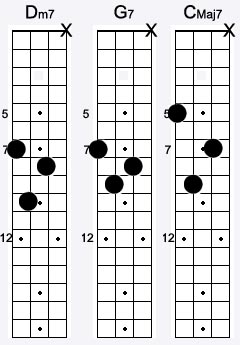
First thing we can do is move it up two frets. Instead of 'Dm7 G7 CMaj7' you have 'Em7 A7 DMaj7'. Note, you didn't learn three new individual chords, you just learned the transposition of three you already knew.
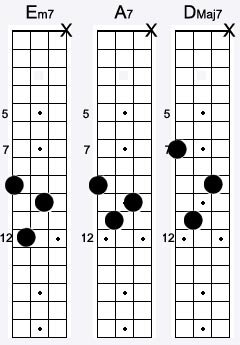
Same thing moving the blocks down two frets, we learn three new chords, not individually, but as a transposition of familiar, now you find yourself playing in a spooky flat key, Bb Major. Your bluegrass friends are impressed, but all you did was move your fingers a few frets lower.
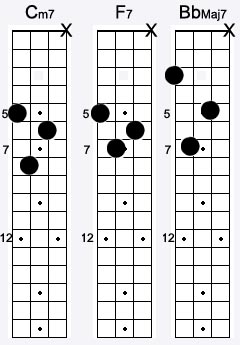
Take the keys in between, and you've learned the basic 'ii V7 I' sentence of some more chromatically intimidating keys, BMaj7 (also enharmonically spelled CbMaj7, by the way) and DbMaj7

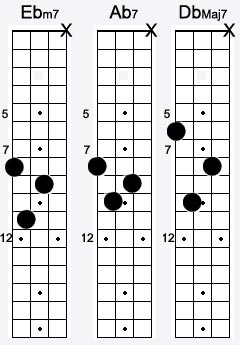
About that DbMaj7. Remember how we said that was a scary key to the folk musician, you just arrived there, as well as learned 15 more chords, simply by moving around the first two you learned from our Playing Card. Take into account there are only 12 keys, you've just now mastered in this short time, the capability of playing HALF of all of them.
This is probably obvious to the veteran jazz player, but it illustrates how much a little bit of theory multiplies fretboard facility. Hopefully, you're getting to the point where you don't even need to look at a chord reference again.
Of course, you can only transpose these so far before you run out of reasonable fingerboard real estate. That's why it's important to learn a few more blocks of the 'ii V7 I', to voice the other six keys, and develop some better voice leading in songs. Take some time to move them around, too.
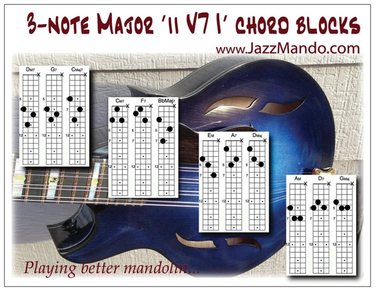
Purchase the whole set: 3-Note Playing Cards
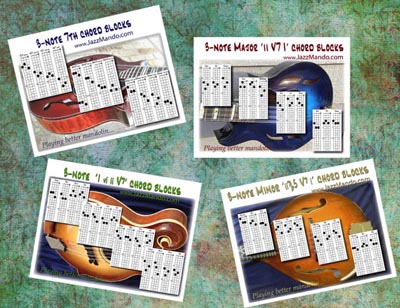
Further
Mobility--chord transit
Major 'ii7 V7 I' 3-note Mandolin Chord Blocks
Tasty Major landing chords
7th Chord Streams. Under the hood.
I hate music theory (Part 1)
Posted by Ted at 9:11 AM
 April 18, 2013 | Best of JM: Thin-slicing and Music Theory
April 18, 2013 | Best of JM: Thin-slicing and Music Theory
Enjoy the popular archive material below.
From December 8, 2011 | Thin-slicing and Music Theory
 Best-selling author Malcolm Gladwell probes into the concept of thin-slicing in his breakthrough book, "Blink: The Power of Thinking Without Thinking." It's a survival concept we take for granted, the ability to assess a multitude of cerebral complexities in situations and compress them into a fast reacting response. Best-selling author Malcolm Gladwell probes into the concept of thin-slicing in his breakthrough book, "Blink: The Power of Thinking Without Thinking." It's a survival concept we take for granted, the ability to assess a multitude of cerebral complexities in situations and compress them into a fast reacting response.
Say a large carton of roof shingles comes tumbling off a roof at a construction site and you happen to be standing beneath at impact. You hear it sliding, look up, and jump out of harm's way. Your reaction is primal instinct. Move. No calculating the speed of the fall, weight of the box, complex formulas of mass and velocity. Protective brain synapsis fire "Move, body!" and you do, sans science or physics. Your decision is reduced, "thin-sliced" out of necessity simply because to survive, or at least avoid a bruising blow, you judge you needed to move.
Music theory is a lot of science and mental calculating. We preach knowing the fundamentals to be able to understand chord context and intentionally create great sounding melodies during improvisation. Knowing when to plug in a Lydian mode or that the dominant chord requires a flatted 7th is important for moving around in music, but we can let it bog us down, especially when the music flows at light speed.
The purpose of drilling scales and modes, practicing chord progression is to internalize them so well you don't have to think. Like stepping out of the way of roofing shingles, you need to be able to just react at that Secondary Dominant chord, and raise the F natural to an F#. When the scales are familiar enough, it becomes more feel than calculation.
Listening to music involves more of this thin-slicing than we realize. Creating music that's intentional and appropriate requires us to be able to thin-slice, too.
Blink is a fascinating read, helpful in understanding our own decision making processes. We encourage you to add it to your library.
Purchase Book:
Kindle: Blink: The Power of Thinking Without Thinking
Blink: The Power of Thinking Without Thinking

Further
Variables
The Basics of Auditioning Instruments
Approaching Improvisation
Suspicion of Melodic Intent
The Jazz Brain; Improv
Posted by Ted at 6:19 AM
 April 11, 2013 | Stella by Starlight 'iiv7b5 V7' Fun
April 11, 2013 | Stella by Starlight 'iiv7b5 V7' Fun
Minor keys often baffle the bluegrass musician. Generally a minor-ish folk song will be more simple, Dorian or Aeolian with it's more static 6th and 7th scale degree is far less challenging than the ever shifting minor keys of jazz. First casualty is the ii chord of the minor mode, most often expressed as a ii7b5. That lowered 6th expressed in this chord means we need to realign the way we express this chord, and it isn't always easy for the novice.
We introduced some block chords in our Tips and Tricks column several weeks ago Major 'ii V7 I' 3-note Mandolin Chord Blocks, and we encouraged you to continue to experiment with transposition. This week we'll take you into a traditional jazz favorite that will allow you to experience how valuable it is to be able to internalize the first two of these chords. The haunting Victor Young ballad is ripe with 'ii7b5 V7' and you'll enjoy a couple variations you can transport into other minor key songs.
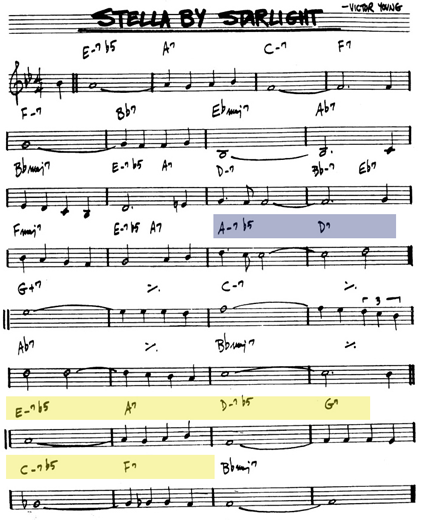
Note the chord progressions at the end we've outlined in yellow have "Circle of 5ths" progressions starting with the Em7b5. We've started this with a block higher in the frets, and you'll see why as you descend. You can play this whole section with just two blocks!
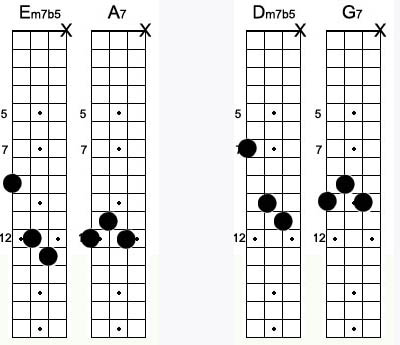
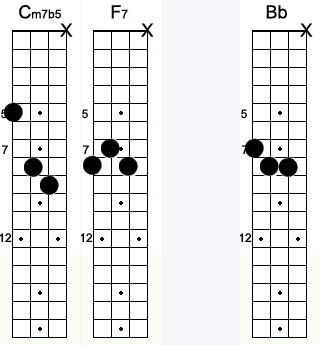
We ended this with a Bb chord like the song, but you can take the Circle of 5ths farther into your own exercise in music theory if you were to continue on with a Bbm7b5:
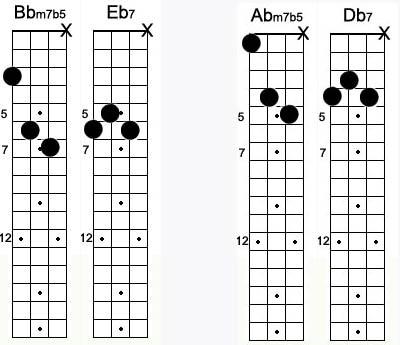
In the pattern we've outlined in blue, you can move the 'iim7b5 V7' up a fret and voice it there, or you can use another chord block higher up the frets we show below:
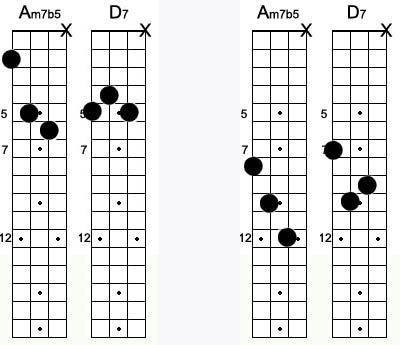
For kicks, how about taking the 'Am7b5/D7' on through some more theory and work it down the fretboard, too:
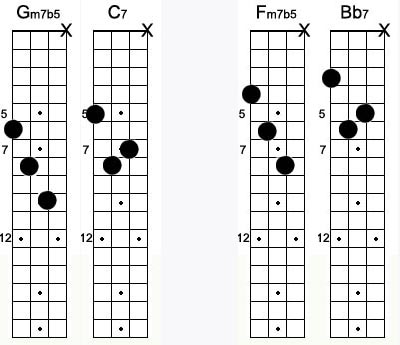
Again, we encourage you to be able to use these blocks in other songs, other keys. Go back and look again at our 'iim7b5 V7 I' grips and come up with your own Circle of 5ths exercises!
Ralph Patt backing track Stella by Starlight
Stella MP3 downloads
Further
m7b5 Chords
Applying minor chord blocks--Black Orpheus
'ii V7 I' and 'ii7b5 V7 i' Home Positions
Vamps. Minor modal
ii7b5 V7 i Minor Patterns
Posted by Ted at 10:12 AM
 April 4, 2013 | Diatonic Major and Minor Chords with Brian Oberlin
April 4, 2013 | Diatonic Major and Minor Chords with Brian Oberlin
For this week's Tips and Tricks article, we have another special treat from guest columnist and Oregon clinician, Brian Oberlin. In addition to his Pacific Northwest teaching and playing schedule, Brian coordinates the prestigious June River of the West Mandolin Camp, one of the finest mandolin workshops in the world. This week, Brian gives an important introduction into the world of music theory specifically for the ears and fingers of the mandolinist.
Quick but important plug in for River of the West, Brian tells us there is still some space available in the camp, but it would be a good idea to get your registration in right away. It's closer than you think! (See link below)
We can only imagine how beautiful the woodlands of Oregon is that time of the year.
Diatonic Major and Minor Chords with Brian Oberlin
Download 2 page PDF:  Diatonic Major and Minor Chords Diatonic Major and Minor Chords
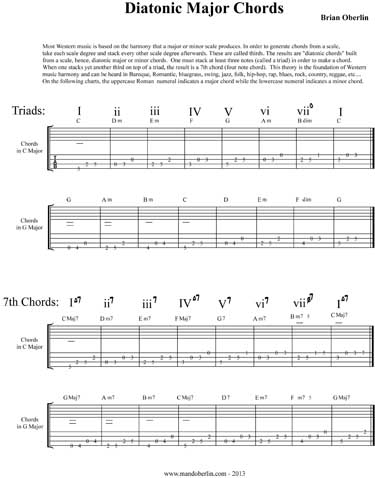
My students are always asking for new tips on improvisation and I consistently tell them that there is no "instant gratification." Meaning, once you learn a new chord and your fingers find it easily, it is instant gratification. Improvisation is not this easy. One must put in the time in order to speak the language of improvisation. The first step is to understand the chords that you will be soloing over. This is my first entry into "Better Improv" and you should familiarize yourself with diatonic chords in major and minor. Learn chord shapes and practice the arpeggios listed. Most importantly, understand the basic rules of what chords are in a key. Once you learn the rules, you can start breaking them and off we go!!!
Any questions, please email me. - Brian Oberlin
www.mandoberlin.com
Read previous Brian Oberlin article:
Voice-leading swing chords and extensions
Camp information: 2013 River of the West Mandolin Camp
June 6 - 9, 2013

Columbia River Gorge, 20 miles east of Portland, Oregon
Further
Fitting in with triads
Vamps. Creating energy with Diatonic triads
Five part series on 3-note vamp chords complete
Vamps. Expanding the Diatonic triads
3-note Mandolin "Playing Cards"
Posted by Ted at 7:19 AM

Disclaimer: In the 'Information Age' of the 21st Century,
any fool with a computer, a modem, and an idea can
become a self-professed 'expert." This site does not
come equipped with 'discernment.'
|



